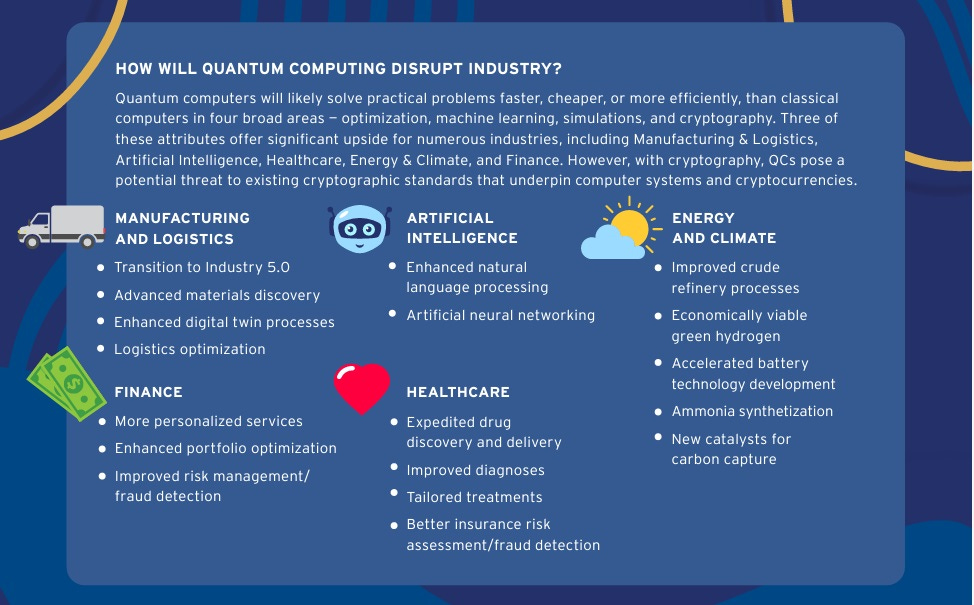🌊 Tech tsunami: AI, quantum computing, and (🤞) superconductors
This is what a historic wave of general-purpose technologies looks like
“If you think you understand quantum mechanics, you don’t understand quantum mechanics.” - Richard Feynman
Room Temperature Superconductor Update:
The Essay
🌊 Tech tsunami: AI, quantum computing, and (🤞) superconductors
Scientists from around the world are attempting to replicate the results of South Korean researchers who claim to have created a lead-based superconductor that can conduct electricity without resistance at room temperature and pressure. As Science magazine puts it, “If true, the discovery would be one of the biggest ever in condensed matter physics and could usher in all sorts of technological marvels, such as levitating vehicles and perfectly efficient electrical grids.”
Given that it’s White Pill Wednesday in the pro-progress, pro-acceleration community, let’s take a moment to flesh out some superconductor speculation. A brief speculative vignette:
Elon Musk gazed out the window of the HyperX hyperloop as it sped across the beautiful American heartland — the wheat fields were now in full amber wave — and thought about how profoundly his adopted country had changed over the past 25 years. He remembered the exhilaration back in 2023 when Caltech researchers had replicated the result of the South Korean scientists who had first synthesized room-temperature superconductors.
Seemingly overnight, a deluge of new venture capital flowed into Silicon Valley as startups began spinning up new technologies. Washington opened the financial taps, too, launching Project Vulcan — named after the Roman god of fire and smithery — to create new superconductor breakthroughs faster than its geopolitical rivals. The Superconductor Race was on against China. And with the private and public sectors each doing their appropriate parts, America and the world entered the Age of Wonders.
Musk remembered the initial euphoria when the first superconducting processors and wireless power grids were developed. Computers achieved unimaginable speeds as quantum effects took hold. Cities began switching to lossless electricity transmission. It was just the beginning. Within a decade, global energy dynamics had shifted. Fossil fuels were obsolete. Electric aviation went mainstream. High-speed rail networks spread across continents. Undersea cities thrived on limitless geothermal energy.
The Midwest rebuilt its entire electrical grid using superconductor transmission lines, revitalizing manufacturing. In the Mountain West, massive spaceship construction yards, run by SpaceX and other companies, took shape. Lightweight superconducting materials meant rocket launches became a daily occurrence. Soon, a thriving off-world economy boomed — lunar mining colonies, Martian research outposts, asteroid mining. America led the charge. Fusion rockets shrank interplanetary travel times to weeks.
At home, room-temperature superconductors became woven into the fabric of American life. Airliners crossed continents in under an hour using supercooled electric engines. AI quantum computers accurately modeled climate shifts and medical cures. The biggest revelations were yet to come, however. Scientists were now manipulating matter and space-time as never before. Beaming power across light years using phased antenna arrays. Fine-tuning fundamental constants. Instantaneous communication via quantum entanglement. Exploring beyond the observable universe through wormholes.
Yes, it’s been quite the quarter century. Now back to sh-t posting on X.
An incoming wave of new technologies
That little short story, which I co-authored with chatbot Claude, may seem like a wispy bit of mere speculation. But it’s important whenever possible to create Up Wing visions of the future in a culture that generates far too few of them, especially compared to numerous dystopian Down Wing ones.
Let’s dial in on just one potential impact of room-temp superconductors. Citigroup just released a lengthy report on quantum computers, probabilistic machines able to perform calculations based on the quantum states of matter such as with atoms or superconducting circuits. It paints a picture of technology almost as ambitious as the above bit of fiction. “The next phase of computing — quantum computing — is getting close to moving from being theoretical to practical, and we are quickly coming to a point where quantum computers will be able to perform tasks faster, more efficiently, and cheaper than classical computers,” the report states.
Given all the potential applications, as seen in the above graphic, it would be safe to call quantum computing a potential general-purpose technology. Not only that, but it would be a GPT that would intersect with another emerging GPT, generative AI. As the Citi report explains:
The ultimate form of AI, artificial general intelligence, should in principle be able to learn anything. The capabilities of AI, however, are largely restricted by the computing power currently available. …With Moore’s Law under pressure in recent years, training larger language models will likely become an even more difficult task for classical computers. We investigate how quantum computing will potentially be able to enhance AI capabilities through two examples: natural language processing and artificial neural networking.
Two key potential applications, according to Citi:
Natural language processing, or NLP, is the technology that allows machines to understand and respond to human language But human language is complex, with various nuances like sarcasm, idioms, and metaphors, making it challenging for machines to interpret accurately. Current NLP systems use machine learning to understand individual words, but they struggle with understanding the overall meaning of sentences and paragraphs.
Quantum computing could offer a new approach by leveraging its probabilistic nature to better mimic how human language works. By using quantum NLB, AI could become "meaning-aware" for the first time, enabling a clearer understanding of the flow of meanings in language. Although this research is still in its early stages, it holds the potential to revolutionize AI's ability to understand and interact with human language.
AI needs to recognize patterns and correlations to achieve general intelligence. Artificial neural networks, inspired by the biological neural networks in our brains, are powerful machine learning models used for this purpose. But as the demand for more human-like AI increases, the size of training datasets grows exponentially, overwhelming even supercomputers.
Quantum computing could offer a solution by potentially solving certain machine learning problems, such as those tackled by artificial neural networks, faster than classical computers. This could lead to significant advancements in AI computing performance, enabling complex simulations and applications in various fields, such as materials development, medical applications, and optimization of complex systems.
This from an inteview Citi analysis did with Jack Hidary, CEO of SandboxAQ (bold by me):
Quantum and AI are synergistic technologies. AI is at its best when we can train it on large amounts of data, but when we look at a novel drug candidate, for example, there is no big data. In these cases, we build up a new data set using the quantum equations governing atomic interactions and then apply AI to that new data to optimize for the best molecular structure to hit that condition. … More and more powerful GPUs are driving the advances we see in AI today. Chips from Nvidia, Alphabet and other companies are giving us unprecedented ability to build larger and larger AI models. However, as the chip industry faces increased challenges in developing chips with even higher density of transistors due to quantum limits, quantum computing will enter the picture. We foresee hybridized classical-quantum computing as a way forward in creating more capable AI models. The field of Quantum Machine Learning (QML) is at an early phase, but picking up momentum. As quantum computers scale further and we can implement error correction on qubits, we will see QML become a powerful tool in the AI toolchest.
The power of combination
In short, quantum computing and AI together create a sort of combinatorial windfall that boosts technological progress and, eventually, economic growth. Now add a third GPT, room-temperature superconductors. In a scenario where quantum computing enables more efficient and powerful AI, those quantum computers need to be supercold. Extremely low temperatures are crucial because the tiny building blocks of quantum computers, called qubits, are very sensitive to any disturbances, especially heat from their surroundings. Quantum computers need temperatures close to absolute zero. And as the report notes, “Ultimately, this need for extreme cooling presents a potential additional bottleneck for the already complex quantum computing supply chain. “
This brings us to room-temperature superconductors, which make quantum computers way easier and more cost-effective to operate. More accurate and powerful, too. Say goodbye to bottlenecks, and say hello to a self-reinforcing web of technological advancements and positive feedback loops. (You can toss in energy advances in geothermal, solar, and nuclear, as well.)
Maybe not, of course. This superconductor news could be a replay of the 1989 “cold fusion” breakthrough that wasn’t. And if the predictions markets are right, that analogy isn’t far off. Forgive me, however, for indulging in optimism that we are seeing a GPT cluster every bit as important — and maybe more — as that of the second phase of the Industrial Revolution: electric light and power, the internal-combustion engine and its use in automobiles, airplanes, wireless communications, and synthetic chemicals. Artificial general intelligence alone might be the equal of that Second IR cluster, it’s own tech boom. But some help would be great, too.
Micro Reads
▶ Inside the DIY Race to Replicate LK-99 - Gregory Barber, Wired |
▶ ‘Wonder and Worry’: How Biden Views Artificial Intelligence - Sabrina Siddiqui, WSJ |
▶ We’re Using A.I. Chatbots Wrong. Here’s How to Direct Them. - Brian X. Chen |
▶ Robotic analysis of perovskites may speed development of solar cells with better than 30% efficiency - IEEE Spectrum |
▶ Are UFOs a Threat to National Security? - Tyler Cowen, Bloomberg Opinion |
▶ The AI rules that US policymakers are considering, explained - Dylan Matthews, Vox |
▶ Geothermal Energy Needs Permitting Reform - Aidan Mackenzie, Institute for Progress |
▶ In Praise of Boring AI - Ethan Mollick, One Useful Thing |
▶ Wired for Success: Reforming Whitehall to support science and technology - Allan Nixon, Anna Dickinson, and Anastasia Bektimirova, Onward |
▶ Autonomous Now: Why We Need Self-Driving Technology and How We Can Get It Faster - Jordan McGillis, Manhattan Institute |





